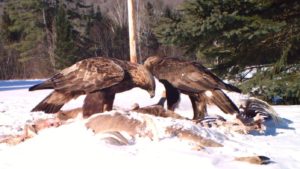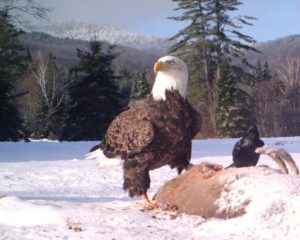BREAKING NEWS: Just published early in 2022 – Two new scientific papers that raise concerns about the impact of lead (Pb) on eagles.
(by Chris Martin)
Both of these ecotoxicological studies are noteworthy, not just because they clearly describe the risks that eagles face of ingesting lead (Pb) fragments from spent hunting ammunition, but also because of the wide geographic scale of each study and the breadth of researcher collaboration involved. If you care about the health of North America’s eagle populations and other wildlife, then you might want to set aside some time to carefully read through these two documents. But first a warning … What you read may disturb you!

The first paper, titled “Environmental lead reduces the resilience of Bald Eagle populations”, appeared in the January 2022 issue of the Journal of Wildlife Management. Researchers found that over the last three decades Bald Eagle population increases in the northeastern U.S. have been suppressed by 6.3% (for males) and 4.2% (for females) and that mortalities from environmental lead ingestion have “reduced the long-term growth rate and resiliency” of eagles. Authored by a team of scientists from the Cornell University Department of Public and Ecosystem Health and three other wildlife health experts, including veterinarian Dr. Mark A. Pokras of Tufts Wildlife Clinic, this study used a population matrix model and real necropsy data gathered in seven northeastern states (CT, MA, ME, NH, NJ, NY, VT) from 1990-2018.
Primary author Brenda J. Hanley and her colleagues noted that raw data supporting the population model were gathered by technicians and field volunteers, and specifically mentioned among others the assistance of NH Audubon volunteers. This publication highlights the important contribution that individuals can make to big research initiatives and shows the value of gathering long-term monitoring data.
Read the abstract or the full paper, here.

The second paper, “Demographic implications of lead poisoning for eagles across North America”, was published in Science in February 2022. This paper looks at chronic and acute lead poisoning in both Bald Eagles and Golden Eagles across 38 states. Continent-wide modeling in this study suggested that lead (Pb) poisoning suppressed population growth rates by 3.8% for Bald Eagles and 0.8% for Golden Eagles. Authored by Vincent Slabe and 28 other highly respected raptor experts, it has serious implications for our resident Bald Eagle population, and for our eastern Golden Eagle population in New Hampshire during migration and over the winter months. One of the authors, Dr. Todd Katzner, founded the Eastern Golden Eagle Working Group, a collaborative of biologists and wildlife managers from the U.S. and Canada dedicated to a better understanding of Golden Eagle ecology across eastern North America. NH Audubon is an active participant in this working group.
Wildlife biologists and policy makers have worked quite hard in recent years to eliminate environmental lead (Pb) from fishing tackle, and this effort has met with significant success. However, the same can’t be said for eliminating this toxic metal from terrestrial ammo. Particularly in the fall and winter, Bald Eagles and Golden Eagles both consume discarded deer remains and gut piles that are often laced with tiny metal fragments created on impact. We need more active efforts, particularly from our state wildlife agencies, to promote non-toxic ammo alternatives to the hunting community, and these two new research papers certainly make the case.
Suggested photo captions:
Two overwintering Golden Eagles feed on deer carcasses near Umbagog NWR in January 2014. Wildlife Cam photo by Janne Provencher.
A resident adult Bald Eagle on a deer carcass near Umbagog NWR in December 2013. Wildlife Cam photo by Janne Provencher.
